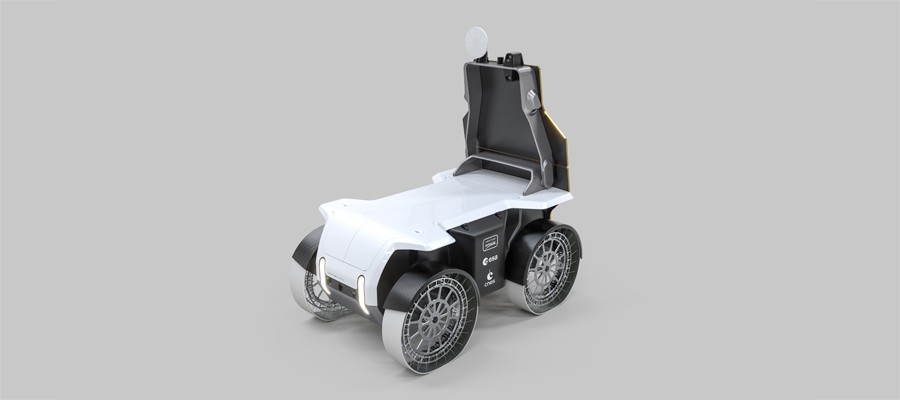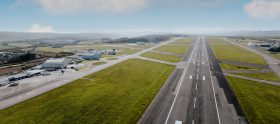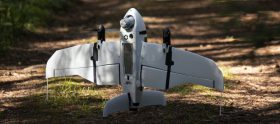Venturi Space presents Mona Luna, the european lunar rover
Venturi Space unveils MONA LUNA, its 100% European-built lunar rover. Designed to support the ambitions of the European Space Agency and the French CNES, the vehicle will be built at Venturi Space France's facility in Toulouse. The ultimate aim is to provide Europe with a lunar-capable rover by 2030.

European autonomy in lunar mobility is a major strategic challenge. Venturi Space is helping to make that a reality with MONA LUNA, its upcoming lunar rover designed to meet the needs of ESA and national European space agencies. The vehicle will further Europe’s efforts to achieve technological independence in the field of lunar mobility, enabling it to get ahead of the industrial curve and achieve its space ambitions.
A project led by Venturi Space France
Venturi Space France will oversee MONA LUNA’s development and space qualification from its base in Toulouse, coordinating every aspect of the process: onboard electronics, avionics, space-to-ground links, energy management systems, assembly, final integration, and acceptance testing in readiness for space flight. All with one clear objective: to deploy MONA LUNA at the Moon’s South Pole by 2030.
Backed by the ESA and CNES
The European Space Agency is supporting Venturi Space’s efforts to design and develop the critical technologies required for a large lunar rover, capable of surviving multiple lunar nights. ESA’s support validates Venturi Space’s approach and highlights its expertise. The project will draw on the experience acquired from the programmes to develop the FLIP and FLEX rovers under a strategic partnership with US-based company Venturi Astrolab, Inc. Venturi Space is currently designing and building the hyper-deformable wheels that will be fitted to those vehicles, along with the associated electrical systems (in Switzerland) and high-performance batteries (in Monaco).
Using technology made in Europe
MONA LUNA is designed to be carried into space by the Ariane 6.4 launch system and landed on the Moon’s surface by the European Argonaut lunar lander, while the rover itself will be equipped with a robotic arm to handle scientific instruments and payloads. It will be:
– electrically powered, recharging via solar panels,
– designed to move autonomously,
– equipped with three high-performance batteries,
– capable of carrying a wide range of payloads,
– designed to survive multiple lunar nights,
– capable of a top speed of 20 km/h,
– designed to weigh a total of 750 kg.
The rover could also be used in an emergency to carry an astronaut in difficulty, as envisaged by the ESA and CNES in their feasibility studies.
A clear commercial purpose
MONA LUNA’s maiden mission will focus on purely scientific applications, but future deployments could be organised to meet demand from the European private sector for a variety of purposes, including carrying payloads to the South Pole, exploiting lunar resources (such as helium-3) in situ, or even public outreach campaigns. This approach will help establish a sustainable long-term economic model for the rover, in much the same way as the early development of terrestrial mobility.
Quotes
Gildo Pastor, President of Venturi Space:
“I’m still an explorer, first and foremost. Space is a new frontier, and MONA LUNA is how we are actually going to broach it. Alongside Europe, we aim to build an autonomous lunar exploration capability to meet the scientific, economic, and strategic challenges of tomorrow.”
Dr. Antonio Delfino, Director of Space Affairs at Venturi Space:
“Our primary focus is to make ourselves fully available to the ESA and European national space agencies. With MONA LUNA, we aim to deliver major technological breakthroughs that will pave the way for extended lunar mobility.”
About Venturi and Venturi Space
Founded in 2000 in Monaco, Venturi has established itself in the field of high-performance electric mobility: world records, expeditions in extreme environments, Formula E, technological innovations, and iconic two- and four-wheeled vehicles. Since 2021, Venturi Space has extended this expertise to space exploration by developing mobility solutions for the Moon and Mars. As a strategic partner of the North American company Venturi Astrolab, the firm designs and manufactures critical technologies – hyper-deformable wheels and high-performance batteries – for the FLIP and FLEX lunar rovers. FLIP will be deployed on the Moon in February 2026. FLEX, meanwhile, has been pre-selected by NASA for crewed missions under the Artemis programme. In this context, Venturi Space (Monaco–Switzerland–France) unveiled MONA LUNA in June 2025 – a 100% European lunar rover developed to support the ambitions of ESA and CNES.
Im Drones PR-Portal erscheinen Nachrichten und Meldungen von Unternehmen aus der Drone-Economy. Für die Inhalte der Pressemitteilungen sind die jeweiligen Unternehmen verantwortlich.







